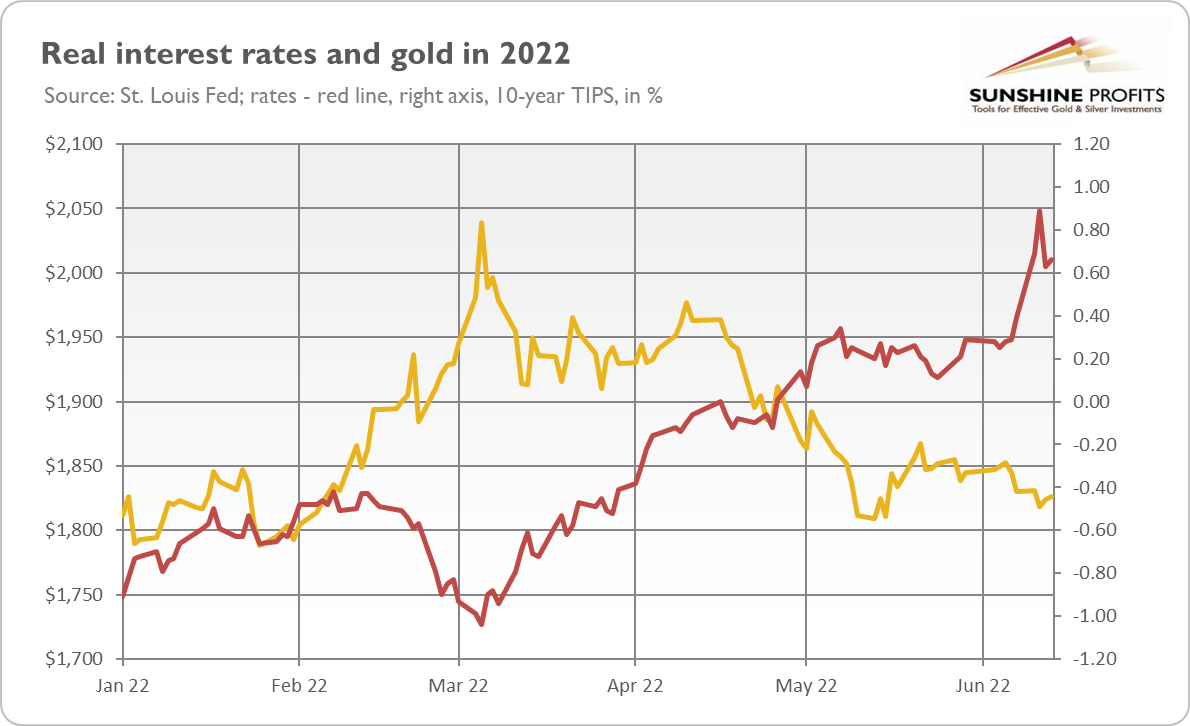The massive monetary binge is over. The Fed is taking the punch bowl away. The hangover is coming. The best cure is – except for the broth – gold.
No Longer Doves
75 basis points! This is how much the FOMC raised interest rates in June. As the chart below shows, it was the biggest hike in the federal funds rate since the 1990s. Due to this huge move, the target range for the federal funds rate returned to the pre-pandemic level of 1.50-1.75%. Given how dovish and gradual the US central bank normally is, we may conclude that the inflation threat is really serious. The Fed has been so far behind the inflation curve that it must raise rates at the fastest pace in more than a quarter of a century!
Last month, the US central bank also started reducing the size of its enormous balance sheet. Until September, the Fed will be cutting $45 billion a month from its massive holdings, and it will increase to $95 billion, almost twice as much as it did in the previous episode of quantitative tightening. As the chart below shows, the value of the Fed’s assets has already peaked, reaching $8.95 trillion in mid-May 2022.
What does it all mean for the US economy? Well, let’s start with the observation that although the Fed is tightening its monetary policy, its stance remains accommodative. According to the Taylor rule, the federal funds rate shouldn’t be just between 1.50% and 1.75%, but at least above 5% (see the chart below taken from the Atlanta Fed)! At such a level, the Fed will be “neutral”, but to beat inflation it should be restrictive, not merely neutral!
It means that the US central bank remains behind the inflation curve and would have to raise interest rates much further to combat high inflation. However, it raises a very important question: could the Fed raise rates so decisively without triggering the next economic crisis? This is, of course, a rhetorical question.
As a reminder, the previous Fed’s tightening cycle of 2017-2019 led to the repo crisis, forcing the US central bank to reverse its stance and cut interest rates. Given how fragile the financial system is and how much indebted the American economy is, it’s almost certain that the current monetary policy tightening will lead to a sovereign-debt crisis or another kind of financial crisis.
Right now, the commercial banks seem to be in healthy condition and with ample reserves, so the risk of a liquidity crisis in the very near future is low. However, as the tightening continues, the debt-servicing costs and share of nonperforming loans will increase, worsening the financial situation. So far, Powell is flexing his muscles, but this is only because the labor market remains strong, but when faced with the choice between fighting inflation and stimulating a crumbling economy, I doubt whether he could withstand the pressure from both Wall Street and the government, which are heavily indebted and addicted to easy money.
Implications for Gold
What does it all imply for the gold market? Well, theoretically, monetary policy tightening should be negative for gold prices, as higher real interest rates usually lead to lower gold prices. However, gold has been generally very resilient during the current tightening cycle. It’s true that it didn’t rally despite the outburst of inflation, but its gave a stellar performance (even when we take July plunge in the account) in the face of rising rates and in comparison to plunging equities or cryptocurrencies, as the charts below show. By the way, it seems that the debate about whether gold or Bitcoin is a better store of value has been settled.
Powell still believes in a soft landing, but he may be the only one. You see, after a gigantic binge, there is always a hangover. When the host of the great party is taking away the punch bowl, drunken guests loudly express their dissatisfaction, which can even translate into brawling. Similarly, after a massive increase in the money supply, there is high inflation that you cannot just wait out, lying in bed and eating broth. You have to hike interest rates, but then borrowing costs are increasing, which hits many excessively indebted companies and investors, and the economic boom translates into a bust.
Busts are awful, but not for gold. The yellow metal rallied during both the Great Recession and the coronavirus crisis (and also during the repo crisis), and I believe that this time won’t be different. We just have to wait until deteriorating economic conditions force the Fed to deviate from its planned course. Initially, when the next crisis hits, there might be a panic sell-off in the precious metals market in order to raise liquidity, but after this short period, gold should rally, shining brightly as a truly safe haven.
All essays, research and information found above represent analyses and opinions of Przemyslaw Radomski, CFA and Sunshine Profits' employees and associates only. As such, it may prove wrong and be a subject to change without notice. Opinions and analyses were based on data available to authors of respective essays at the time of writing. Although the information provided above is based on careful research and sources that are believed to be accurate, Przemyslaw Radomski, CFA and his associates do not guarantee the accuracy or thoroughness of the data or information reported. The opinions published above are neither an offer nor a recommendation to purchase or sell any securities. Mr. Radomski is not a Registered Securities Advisor. By reading Przemyslaw Radomski's, CFA reports you fully agree that he will not be held responsible or liable for any decisions you make regarding any information provided in these reports. Investing, trading and speculation in any financial markets may involve high risk of loss. Przemyslaw Radomski, CFA, Sunshine Profits' employees and affiliates as well as members of their families may have a short or long position in any securities, including those mentioned in any of the reports or essays, and may make additional purchases and/or sales of those securities without notice.
Recommended Content
Editors’ Picks

GBP/USD trades at fresh 2025-high above 1.3250 after UK CPI data
GBP/USD builds on its six-day winning streak and trades at its highest level since October above 1.3250 in the European session on Wednesday. The data from the UK showed that the annual CPI inflation softened to 2.6% in March from 2.8% in February but had little impact on Pound Sterling.

Gold price approaches $3,300 mark amid persistent safe-haven demand
Gold price continues scaling new record highs through the Asian session on Wednesday and has now moved well within striking distance of the $3,300 round-figure mark. Persistent worries about the escalating US-China trade war and US recession fears amid the ongoing US tariff chaos continue to boost demand for gold.

EUR/USD rises to near 1.1350 ahead of Eurozone HICP inflation data
EUR/USD is trading around 1.1340 during the Asian hours on Wednesday, rebounding after two consecutive sessions of losses. The pair is drawing support from a more positive global risk sentiment, buoyed by US President Donald Trump's decision to exempt key technology products from his newly announced “reciprocal” tariffs.

Exchange inflows surge as XRP slides, what comes next?
Ripple corrected along with other major digital assets, including Bitcoin and Ethereum, and traded at $2.08 at the time of writing on Wednesday. The drawdown cut across the crypto market, causing the total capitalization to drop 3.2% to $2.736 trillion.

Is a recession looming?
Wall Street skyrockets after Trump announces tariff delay. But gains remain limited as Trade War with China continues. Recession odds have eased, but investors remain fearful. The worst may not be over, deeper market wounds still possible.

The Best brokers to trade EUR/USD
SPONSORED Discover the top brokers for trading EUR/USD in 2025. Our list features brokers with competitive spreads, fast execution, and powerful platforms. Whether you're a beginner or an expert, find the right partner to navigate the dynamic Forex market.




